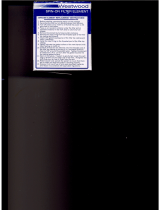
SAFETY INSTRUCTIONS
Your rotary mower at the time of its manufacture,
meets the blade safety requirements of the Con-
sumer Product Safety Commissions Safety Stan-
dard for Walk Behind Power Lawn Mowers.
A
representative sample was tested and verified by
an independent laboratory for compliance with
the B71.1-1980 Specifications of the American
National Standards Institute. However, improper
use or maintenance by the operator or owner
can still result in injury. To reduce the potential
for injury follow these safety instructions.
6. Wear long pants and substantial shoes.
Do
not operate the mower while wearing
sandals, tennis shoes, sneakers or shorts.
Do not wear loose fitting clothing that could
get caught in moving parts.
7.
If
long grass will be cut, set the height-of-cut
in the highest position. After mowing, rein-
spect the area and remove all debris. Then
lower the height-of-cut and mow the grass
again.
8. Since gasoline is highly flammable, handle it
carefully
This machine is equipped with a blade brake
which is designed to stop the blade within
3
A. Use an approved gasoline container.
B.
Do not
fill
the fuel tank when the engine is
seconds when the control lever is released.
Check to be sure the control and brake function
hot or running.
correctly before each use of the mower. Repair
C. Do not smoke while handling gasoline.
D.
Fill the fuel tank outdoors and up to about
any defective or damaged safety components
before operation is commenced. To further
one-half inch from the top of the tank, not
the filler neck.
reduce the possibility of injury, always stop the E. Wipe up any spilled gasoline.
engine before leaving the operator’s position.
While Operating
9. Cutting the grass with a rotary mower de-
This safety symbol means
mands attention. Always maintain secure
WARNING
or
CAUTION
-
footing, balance and control.
PERSONAL SAFETY INSTRUCTION
-
10. Cut the grass during the daytime or when
Read the instruction because
it
has to
there
is
adequate artificial light. Cut slopes
do
with safety. Failure to comply with
from side to side, but avoid slopes when the
the instruction may result in personal
grass is wet.
If
possible, mow when the grass
injury.
is dry for best results.
11. Keep face, hands and feet away from the
Before Operating
mower housing and cutter blade while the
1.
Operate your mower only after reading the engine is running. Stay behind the handle
Operators Manual.
A
replacement manual is
available by sending the complete model 12. During operation the grass defector
or
com-
and serial number to: The Toro Company, plete bagging assembly must be installed on
81 11 Lyndale Avenue South, Minneapolis, the mower.
Minnesota
55420.
Attn: Publications. 13. Stop the engine and wait for all moving parts
2.
Never allow children to operate the mower
to stop before removing the bag, bagging
or adults to operate mower without
assembly, or unclogging the discharge
proper instructions.
chute.
If
the chute must be unclogged, pull
3. Become familiar with the controls and know
the high tension wire from the spark plug to
how to stop the engine quickly.
prevent the possibility
of
accidental starting.
4.
Keep everyone, especially children and pets,
Use a stick to remove the obstruction.
away from the area of operation. Remove
14.
If
a solid object is hit by the blade or
if
the
sticks, stones, wire and any other debris that
mower vibrates abnormally, stop the engine
might be picked up and thrown by the blade.
immediately. Disconnect the high tension
5.
TAMPERING WITH
OR
DEFEATING
A
wire from the spark plug to prevent the
SAFETY DEVICE
OR
COMPONENT WHICH
possibility of accidental starting. Then check
RESULTS IN NONCONFORMANCE WITH
A
the mower for possible damage, bent blade,
an obstruction or loose parts. Repair the
-
SONAL INJURY. Each time before operating
mower before using it again.
the mower, check for damage or abnormal
15. Stop the engine before adjusting the
wear.
If
a safety device, shield, or decal
is
height-of-cut.
defective or damaged, repair or replace it
16.
If
a gravel driveway, road or path must be
before operation is commenced.
crossed, stop the engine
so
loose sand and
until the engine and all moving parts stop.
SAFETY STANDARD, MAY RESULT IN PER-
1-1




















